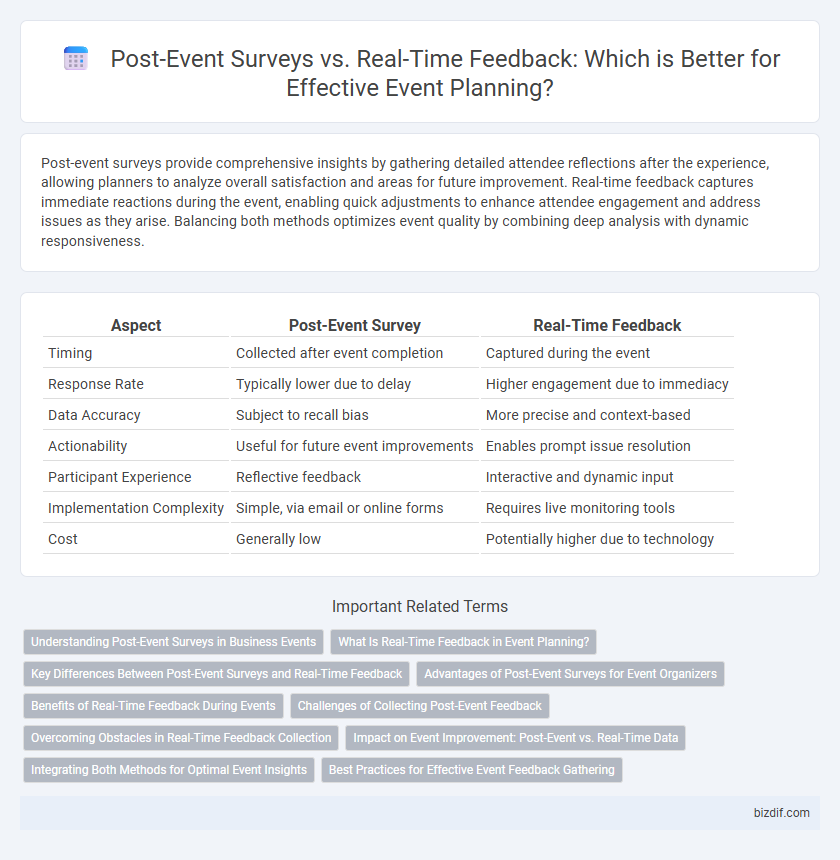Post-event surveys provide comprehensive insights by gathering detailed attendee reflections after the experience, allowing planners to analyze overall satisfaction and areas for future improvement. Real-time feedback captures immediate reactions during the event, enabling quick adjustments to enhance attendee engagement and address issues as they arise. Balancing both methods optimizes event quality by combining deep analysis with dynamic responsiveness.
Table of Comparison
| Aspect | Post-Event Survey | Real-Time Feedback |
|---|---|---|
| Timing | Collected after event completion | Captured during the event |
| Response Rate | Typically lower due to delay | Higher engagement due to immediacy |
| Data Accuracy | Subject to recall bias | More precise and context-based |
| Actionability | Useful for future event improvements | Enables prompt issue resolution |
| Participant Experience | Reflective feedback | Interactive and dynamic input |
| Implementation Complexity | Simple, via email or online forms | Requires live monitoring tools |
| Cost | Generally low | Potentially higher due to technology |
Understanding Post-Event Surveys in Business Events
Post-event surveys provide comprehensive insights into attendee satisfaction, session quality, and overall event impact by gathering detailed feedback after the event concludes. These surveys enable event planners to analyze trends, measure success metrics, and identify improvement areas for future events. Collecting post-event data supports strategic decision-making and enhances the effectiveness of business event planning.
What Is Real-Time Feedback in Event Planning?
Real-time feedback in event planning involves collecting attendee responses during the event to immediately assess satisfaction, engagement, and issues, enabling organizers to make on-the-spot improvements. Unlike post-event surveys, which gather opinions after the event concludes, real-time feedback leverages tools like mobile apps, live polls, and interactive kiosks to provide instant insights. This proactive approach enhances the overall event experience by addressing concerns promptly and adapting content to meet audience needs dynamically.
Key Differences Between Post-Event Surveys and Real-Time Feedback
Post-event surveys provide comprehensive insights gathered after an event, allowing for detailed analysis of attendee satisfaction and overall experience. Real-time feedback captures immediate reactions during the event, enabling event planners to address issues promptly and enhance engagement on the spot. The key difference lies in timing and responsiveness, with post-event surveys informing future improvements while real-time feedback drives instant adjustments.
Advantages of Post-Event Surveys for Event Organizers
Post-event surveys provide event organizers with comprehensive data that captures attendees' overall experiences and satisfaction levels after the event concludes. This method allows organizers to analyze detailed feedback on various aspects such as content quality, venue, and logistics, enabling targeted improvements for future events. The structured nature of surveys facilitates quantifiable insights, making it easier to identify trends and measure success against predefined objectives.
Benefits of Real-Time Feedback During Events
Real-time feedback during events enables immediate identification of attendee needs and preferences, allowing organizers to make on-the-spot adjustments that enhance participant satisfaction. Unlike post-event surveys, which rely on retrospective input, real-time feedback captures authentic reactions, increasing the accuracy and relevance of data collected. This approach fosters higher engagement and helps optimize event outcomes by addressing issues as they arise.
Challenges of Collecting Post-Event Feedback
Collecting post-event feedback often faces challenges such as low response rates due to participant disengagement after the event ends, resulting in incomplete data. Memory decay can lead to less accurate or biased responses, as attendees may forget specific details over time. Unlike real-time feedback, post-event surveys struggle to capture immediate emotional reactions, making it harder to assess on-the-spot satisfaction and issues precisely.
Overcoming Obstacles in Real-Time Feedback Collection
Real-time feedback collection in event planning faces obstacles such as low participant engagement and technical issues with digital tools. Utilizing mobile apps with user-friendly interfaces and offering incentives can significantly increase response rates and data accuracy during the event. Integrating real-time analytics platforms helps instantly identify and address attendee concerns, improving overall event experience and outcomes.
Impact on Event Improvement: Post-Event vs. Real-Time Data
Post-event surveys provide comprehensive insights by aggregating attendee experiences, allowing planners to identify overarching trends and areas for future improvement. Real-time feedback captures immediate reactions, enabling on-the-spot adjustments that enhance attendee satisfaction during the event. Combining both methods maximizes event improvement by leveraging actionable data to refine planning strategies and boost overall effectiveness.
Integrating Both Methods for Optimal Event Insights
Integrating post-event surveys with real-time feedback offers a comprehensive view of attendee experiences, capturing immediate reactions alongside reflective responses. Real-time feedback enables event planners to address issues instantly, enhancing satisfaction during the event, while post-event surveys provide in-depth analysis for future improvements. Combining these methods maximizes data accuracy and actionable insights for optimizing event success and attendee engagement.
Best Practices for Effective Event Feedback Gathering
Post-event surveys offer comprehensive insights by allowing attendees to reflect thoroughly, resulting in detailed feedback on overall event satisfaction and specific elements such as speakers, venue, and logistics. Real-time feedback captures immediate attendee reactions during the event, enabling organizers to address issues promptly and enhance the ongoing experience. Combining both methods optimizes feedback quality, driving continuous improvement through timely adjustments and deep post-event analysis.
Post-event survey vs Real-time feedback Infographic

 bizdif.com
bizdif.com